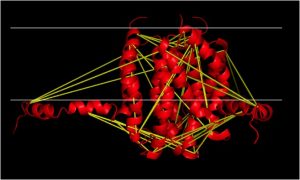About 30% of the proteins in the human body are membrane proteins. They have a wide variety of functions within the cell and it is therefore not surprising that over half of all known drugs target them. However, less than 1% of the structures deposited in the ProteinDataBank belong to membrane proteins. The reason for this discrepancy is the difficulty to crystallize them. Also conventional liquid-state NMR techniques reach their limits for membrane proteins because their slow tumbling rate results in line-broadening that makes it difficult to resolve the peaks compounded by the low spectral dispersion of mostly helical proteins. Therefore, NMR restraints usually remain sparse. In contrast, common structure calculation programs (like Dyana or Xplor/CNS) that compute protein structures from NMR restraints require a large number of restraints because their energy scoring functions are of very high resolution. This is mostly given for soluble proteins but remains problematic for membrane proteins. To close this gap we are developing an algorithm that will be tailored to predict membrane protein structures from the sequence with the use of sparse NMR restraints. The basis is the BCL::Fold algorithm which is a de novo structure prediction algorithm where the energy scoring terms for the initial assembly step are of low resolution. This enables the combination of the algorithm with sparse NMR restraints or restraints from NMR, EPR, Cryo-EM, and crystallography during the folding of the protein. A high-resolution refinement will be applied to recover side-chain conformations.

Current Project Members: Georg Kuenze
Alumni Project Members: Julia Koehler Leman, Brian Weiner, Andrew Levin
